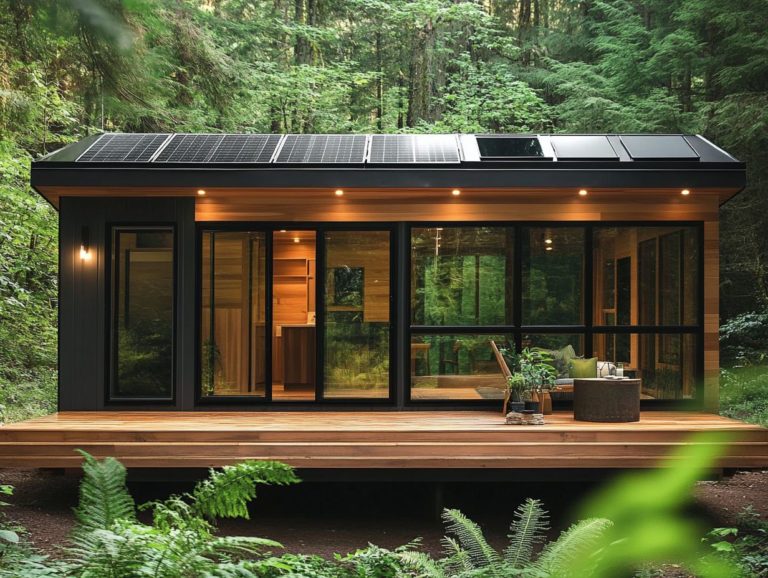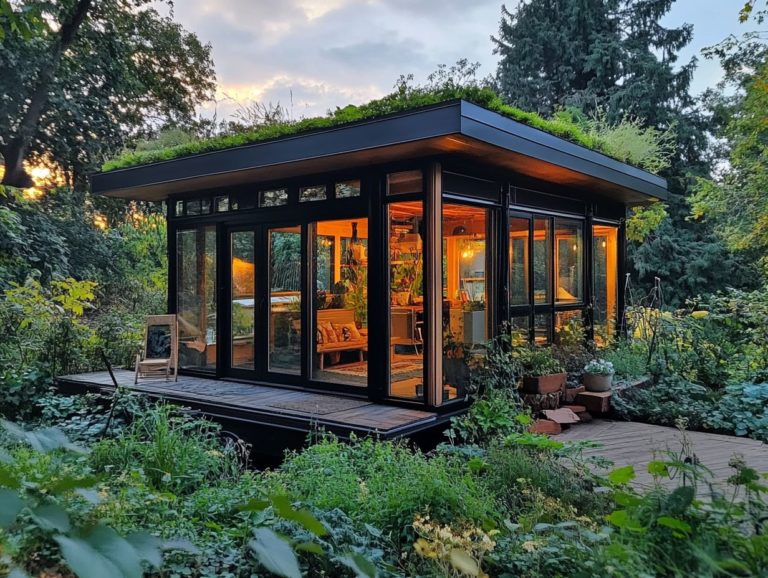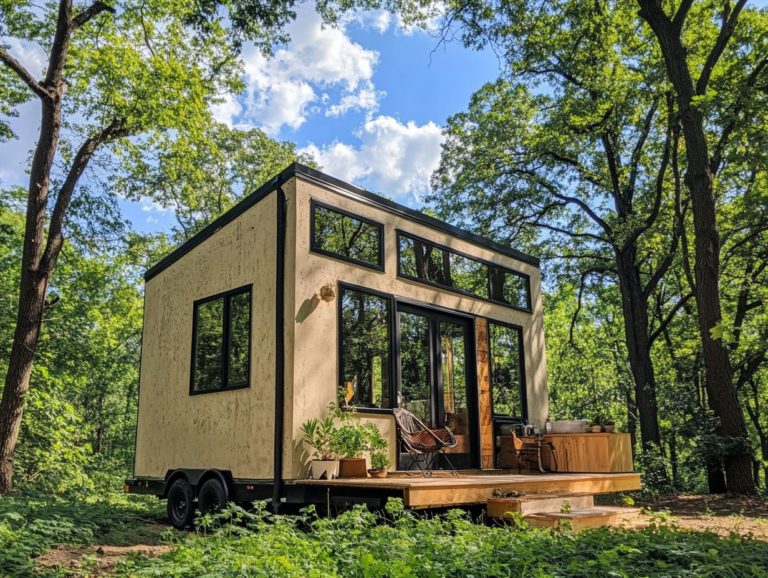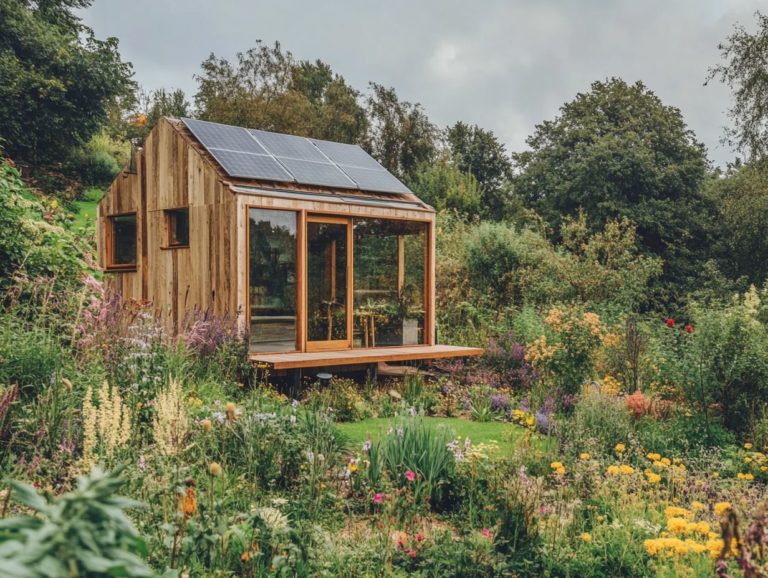How to Choose Eco-Conscious Materials for Tiny Living
In today s vibrant movement towards sustainability, selecting eco-conscious materials for your tiny living space has become essential.
This article delves into the myriad benefits of these materials, from reducing your environmental footprint to cutting costs. It also considers vital factors such as location, building codes, and your personal preferences.
Get ready to explore an exciting array of materials that can transform your tiny living space! You ll find natural, recycled materials, and energy-efficient options that contribute to a more sustainable living environment.
You will also find eco-friendly tips for integrating these choices into your tiny home design. Embrace a greener lifestyle while optimizing efficiency and comfort!
Contents [hide]
- Key Takeaways:
- Benefits of Using Eco-Conscious Materials for Tiny Living
- Factors to Consider When Choosing Eco-Conscious Materials
- Types of Eco-Conscious Materials for Tiny Living
- How to Incorporate Eco-Conscious Materials into Your Tiny Home
- Frequently Asked Questions
- What are eco-conscious materials and why are they important for tiny living?
- How can I identify eco-conscious materials for my tiny living space?
- What are some eco-friendly alternatives to traditional building materials for a Tiny Home?
- How can I ensure that the materials I choose for my Tiny Home are non-toxic?
- Are there any eco-conscious materials that are also cost-effective for Tiny Homes?
- What are some tips for choosing eco-conscious materials for my Tiny Home on a budget?
Key Takeaways:
- Consider the environmental impact and sustainability of materials for tiny living.
- Account for location, climate, and personal needs when choosing materials.
- Explore natural, recycled, and low-impact options to enhance your tiny home.
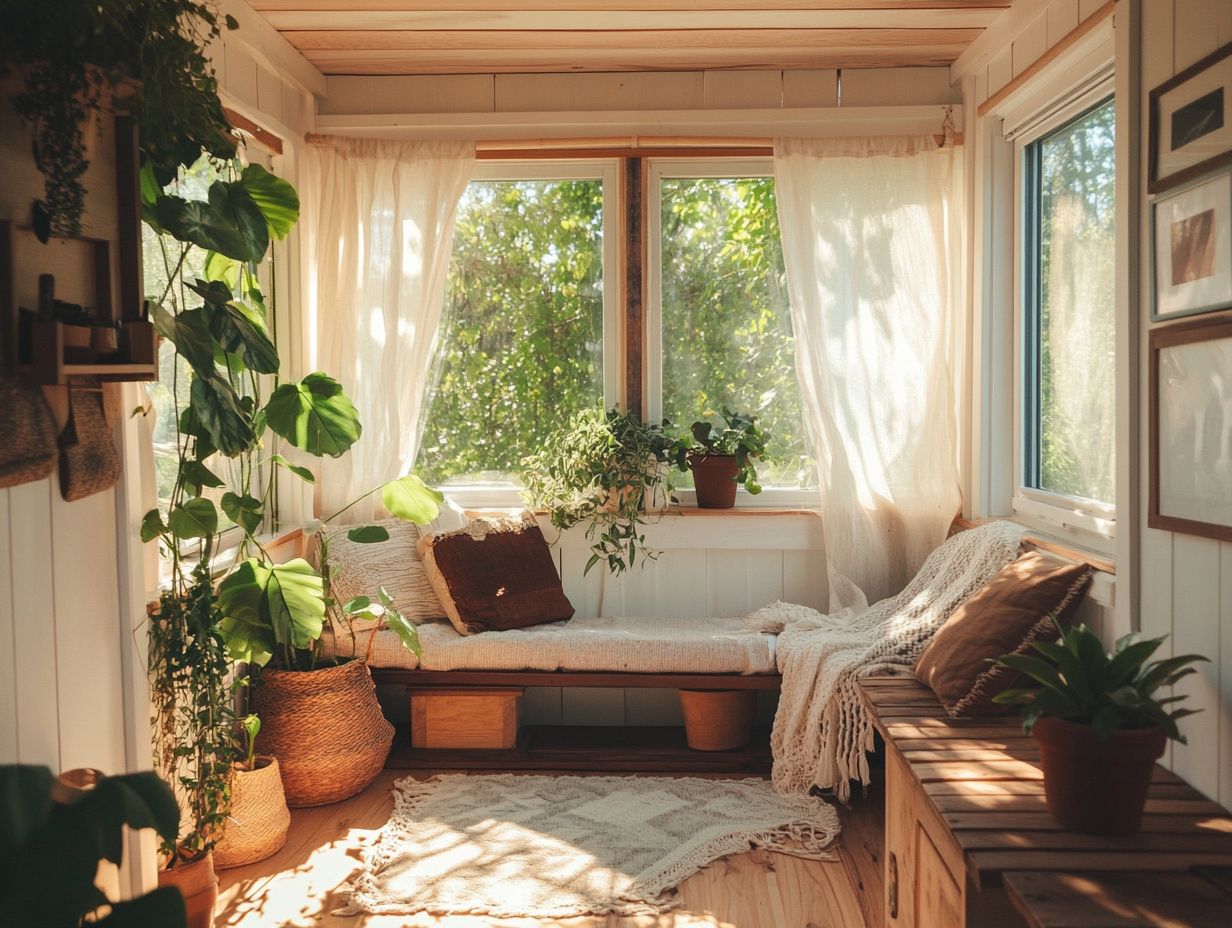
Defining Eco-Conscious Materials
Eco-conscious materials are crucial for crafting a sustainable living environment, especially in tiny homes, where every building material choice can significantly impact your overall carbon footprint. From natural light to recycled materials, every choice counts.
Materials like reclaimed wood, bamboo, and hempcrete not only enhance energy efficiency but also ensure that your living space remains safe and healthy by using nontoxic materials and recycled options. This supports a green home.
By prioritizing eco-friendly choices, you can make informed decisions that support sustainable construction and pave the way for a greener future.
As you explore eco-conscious materials, you ll discover unique advantages, such as durability and excellent thermal performance. These qualities make them perfect for compact living spaces.
For instance, recycled steel provides remarkable strength while reducing waste, and straw bales offer outstanding insulation that can significantly lower your energy costs.
Consider mycelium, a natural material made from fungi; it s biodegradable and boasts impressive fire-resistance properties, making it a valuable addition to sustainable building supplies.
Together, these materials embody the principles of sustainable living, empowering tiny home dwellers like you to embrace environmental stewardship while enjoying modern amenities without sacrificing ecological integrity.
Benefits of Using Eco-Conscious Materials for Tiny Living
Incorporating eco-conscious materials into tiny living is a powerful way to champion sustainable practices while reaping a host of benefits. This approach not only lowers energy costs but also enhances the health and well-being of the inhabitants.
By choosing eco-friendly options, such as energy-efficient appliances, low-flow showerheads, and a composting toilet, you can significantly reduce your carbon footprint.
Imagine a living space bathed in natural light, adorned with lush greenery, including indoor plants and even your very own edible herbs and vegetables.
This holistic strategy for building tiny homes transforms them into cozy havens that also contribute to a healthier environment through the use of solar energy and sustainable practices.
Environmental Impact and Sustainability
The environmental impact of using eco-conscious materials in tiny homes is nothing short of transformative. By selecting these sustainable options, you significantly enhance your home’s sustainability. This choice effectively reduces your carbon footprint.
Choosing eco-friendly alternatives like composting toilets and energy-efficient appliances allows you to minimize waste and save resources. This shift towards sustainable living alleviates harm to the environment while cultivating a more resilient future for communities.
Consider incorporating materials like bamboo, which grows rapidly and produces more oxygen than traditional timber. Choosing bamboo shows how your smart decisions can make a real difference for our planet!
Using recycled steel serves a dual purpose: it repurposes existing resources and cuts down the energy required for new production. This contributes to lower energy costs and greenhouse gas emissions.
With energy-efficient systems, like solar panels and superior insulation, you can rely less on fossil fuels. This further shrinks your carbon footprint and contributes to a green home. These eco-conscious materials not only champion sustainability but also ignite a broader movement towards a more responsible lifestyle.
Cost Savings and Efficiency
Incorporating eco-conscious materials into tiny homes can lead to significant cost savings and enhanced efficiency over time. This makes eco-friendly living both practical and affordable for you.
By utilizing sustainable building materials that boost energy efficiency, such as reclaimed wood and energy-efficient appliances, you can dramatically lower your energy costs. This optimization improves your living environment.
This financial benefit supports your sustainable living lifestyle and inspires others to adopt eco-friendly practices in their own homes. Together, we can address the housing crisis.
Studies show that well-insulated tiny houses can slash heating and cooling costs by up to 40%. This means a noticeable dip in your monthly utility bills.
By harnessing natural resources like solar panels, you can amplify these savings even further. Some homeowners report a return on investment in as little as five years.
The long-term impact of using eco-conscious materials reduces reliance on non-renewable resources. This also boosts local economies by creating jobs that help the environment.
As more individuals recognize these financial perks, the allure of sustainable housing will surely grow. This fosters a broader shift toward conscientious living.
Factors to Consider When Choosing Eco-Conscious Materials
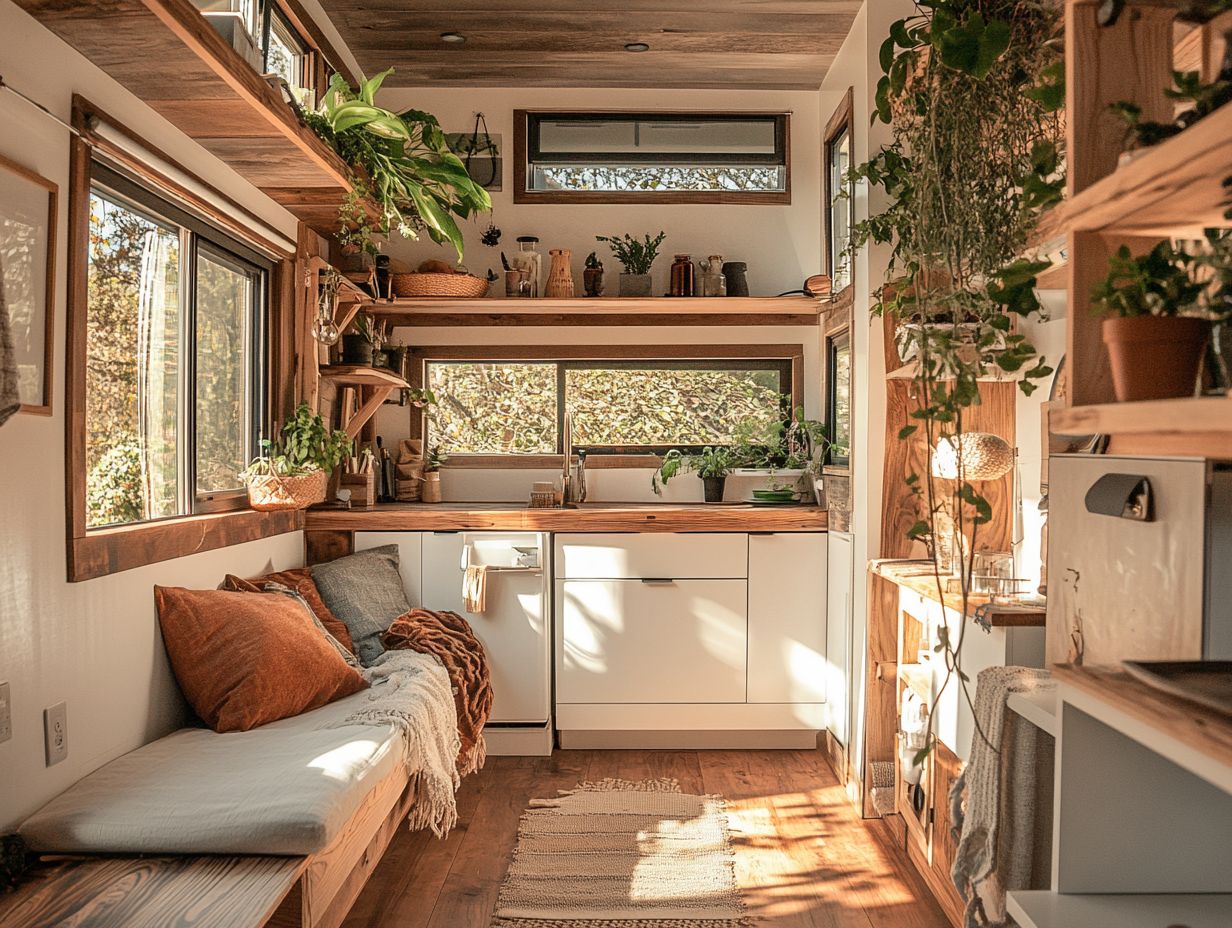
When you re choosing eco-conscious materials for tiny living, several critical factors must be weighed. This includes the availability of building supplies.
It s essential to ensure your choices align with your sustainable living goals and local regulations. Consider the location and climate of your building site, as these elements significantly impact material performance.
Don t overlook the importance of adhering to building codes that promote both safety and sustainability. This ensures that your selections are practical and effective.
Your personal needs and preferences will be instrumental in determining the most suitable eco-friendly materials. This ensures that your tiny home meets both functional requirements and aesthetic aspirations.
Start making eco-friendly choices today and join the movement for a sustainable future!
Location and Climate
The location and climate of your tiny home are crucial in deciding which eco-friendly materials are best suited for sustainable living. Consider factors like temperature fluctuations, humidity levels, and weather patterns when selecting building materials that ensure durability and performance. For instance, if you re in a high-moisture area, it s essential to use materials resistant to mold and decay. Reclaimed wood treated with nontoxic finishes can provide both longevity and safety.
If you find yourself in an arid climate, consider using materials like adobe, stucco, or straw bales to help regulate temperature and provide excellent insulation. These choices reflect your commitment to eco-conscious living and resonate with local building traditions that prioritize sustainability.
In regions prone to heavy snowfall, opting for structural insulated panels (SIPs) panels made of foam insulation sandwiched between two layers of structural board or insulated concrete forms (ICFs) is wise, as they can withstand harsh weather while maintaining energy efficiency. Understanding the specific challenges presented by your location allows you to make smarter material choices, fostering a sustainable lifestyle that harmonizes beautifully with your environment while embracing indoor plants for added benefits.
Building Codes and Regulations
Understanding building codes and regulations is vital when selecting eco-conscious materials for tiny homes. Compliance ensures safety and promotes sustainability throughout the construction process. These codes often dictate which materials are permissible, guiding you toward eco-friendly options that align with local standards.
For example, specific regulations may address the use of materials like straw bales or hempcrete, both of which play pivotal roles in sustainable living practices.
By adhering to these codes, you actively mitigate risks related to structural integrity and environmental impact, ensuring your tiny home remains a model of sustainable living. Regulations typically encompass requirements regarding insulation properties, fire resistance, and energy efficiency elements crucial for tiny home designs.
Energy codes may necessitate adequate thermal performance, steering you toward the selection of recycled or renewable insulation options. Zoning laws determine where tiny homes can be situated, sparking broader discussions about community planning and how to embrace minimalism in tiny living and the feasibility of greener living spaces.
These frameworks not only promote thoughtful material selection but also inspire innovative strategies that support both safety and sustainability in your living environments.
Personal Needs and Preferences
Your personal needs and preferences play a significant role in selecting eco-conscious materials for your tiny home. This ensures that your living space aligns seamlessly with your unique lifestyle and values.
This thoughtful selection process is not just about meeting immediate practical requirements. It s about creating a sanctuary that resonates with your identity and promotes well-being. Choosing durable materials that withstand daily use while reflecting your aesthetic fosters a deeper emotional connection to your home.
When you choose materials that echo your values, you enhance the joy from sustainable living, transforming your house into a haven that champions both environmental stewardship and personal comfort.
Insulation quality and energy-efficient fixtures are vital in maintaining a harmonious home environment that encourages mindful consumption and supports a simpler lifestyle.
Types of Eco-Conscious Materials for Tiny Living
You have access to a wealth of eco-conscious materials for tiny living, each with distinct advantages that enhance energy efficiency and sustainability.
You can choose from various eco-conscious materials that fit your needs:
- Natural and renewable options
- Recycled and upcycled materials
- Low-impact solutions that significantly reduce environmental impact
By carefully selecting the right mix of eco-friendly materials, you can imagine crafting a tiny home that captivates the eye and inspires others, all while aligning harmoniously with your commitment to environmental responsibility. Explore sustainable design practices for tiny houses to enhance your project’s impact.
Natural and Renewable Materials

Natural and renewable materials are essential for constructing eco-friendly tiny homes. They provide you with sustainable options.
Materials like hempcrete, cork, and recycled metal offer exceptional heat protection and durability, making them ideal for various climates. Bamboo, with its rapid growth and strength, emerges as a standout renewable resource. Reclaimed wood adds a unique character to each structure, weaving a narrative of its past.
Don t overlook straw bales; they deliver excellent heat protection and present a cost-effective building solution, further enhancing sustainability.
When you compare these alternatives to traditional materials like concrete and steel, you will find that they not only conserve energy but also significantly reduce greenhouse gas emissions. This makes them appealing choices for eco-conscious builders like yourself.
Recycled and Upcycled Materials
Recycled and upcycled materials are essential components of eco-conscious tiny homes. They offer innovative ways for you to reduce waste while embracing sustainable living practices. By incorporating materials like recycled steel or upcycled furniture, you not only minimize your environmental impact but also infuse your living space with unique character.
Reclaimed wood brings warmth and charm to your interiors. Old shipping pallets? They can be transformed into stylish outdoor furniture or rustic decor for your home. Creative thinkers have even repurposed salvaged windows and doors into stunning room dividers or artistic wall features, ensuring that these materials are both functional and visually appealing.
Opting for repurposed materials often results in cost savings, allowing you to allocate more funds toward sustainable technologies like solar panels or composting systems. Additionally, choosing the right furniture for tiny homes can enhance your space while embracing recycled and upcycled materials, creating a holistic approach to eco-friendly living that reflects your commitment to sustainability.
Low-Impact and Energy-Efficient Materials
Low-impact and energy-efficient materials are crucial to creating your eco-conscious tiny home. They significantly enhance both sustainability and comfort. Think high-quality insulation, appliances that save energy, and low-flow showerheads all of these choices contribute to reduced energy consumption and lower utility bills.
Utilizing reclaimed wood for structural elements helps minimize waste and adds a unique charm and a touch of history to your home. Incorporating bamboo flooring is another savvy decision; as a rapidly renewable resource, bamboo brings natural beauty and impressive durability to your space.
Imagine the difference! Choosing low-VOC paints and finishes promotes better indoor air quality, which is essential in smaller living areas.
Together, these materials foster a healthier lifestyle while shrinking your environmental footprint, demonstrating how thoughtful selections can create a harmonious balance between comfort and eco-responsibility.
How to Incorporate Eco-Conscious Materials into Your Tiny Home
Incorporating eco-conscious materials into your tiny home demands thoughtful consideration of both design and construction practices, ensuring that sustainability remains at the forefront of every decision.
By carefully selecting eco-friendly materials that resonate with your vision such as reclaimed wood, bamboo, and appliances that save energy you can craft a harmonious living space that reflects your values.
This journey encompasses not just the choice of materials but also the construction techniques employed. Maximize energy efficiency and reduce waste by choosing the right construction techniques.
Take your first step toward using eco-conscious materials today!
Design and Construction Considerations
When you re planning the design and construction of your tiny home, it’s vital to embrace eco-friendly practices that champion sustainable living and minimize your carbon footprint. Thoughtful planning gives you the power to maximize natural light, incorporate energy-efficient appliances, and utilize renewable materials. This creates a space that is both functional and visually appealing. This holistic approach ensures that every aspect of your building process aligns with eco-conscious principles.
One key element to consider is the layout. Favor an open design to enhance airflow and reduce your dependence on artificial heating and cooling. Choosing sustainable materials, such as reclaimed wood or bamboo, is crucial. For those interested in building, exploring the best materials for tiny house construction not only reduces your environmental impact but also adds unique character to your home.
Use innovative construction techniques, such as modular or prefabricated methods. These can significantly cut down on waste and construction time. Features like roofs covered with plants that help insulate the house or rainwater harvesting systems boost energy efficiency and elevate the overall resilience of your home.
These thoughtful considerations culminate in a living space that beautifully harmonizes with both nature and contemporary needs.
Maintenance and Upkeep Tips
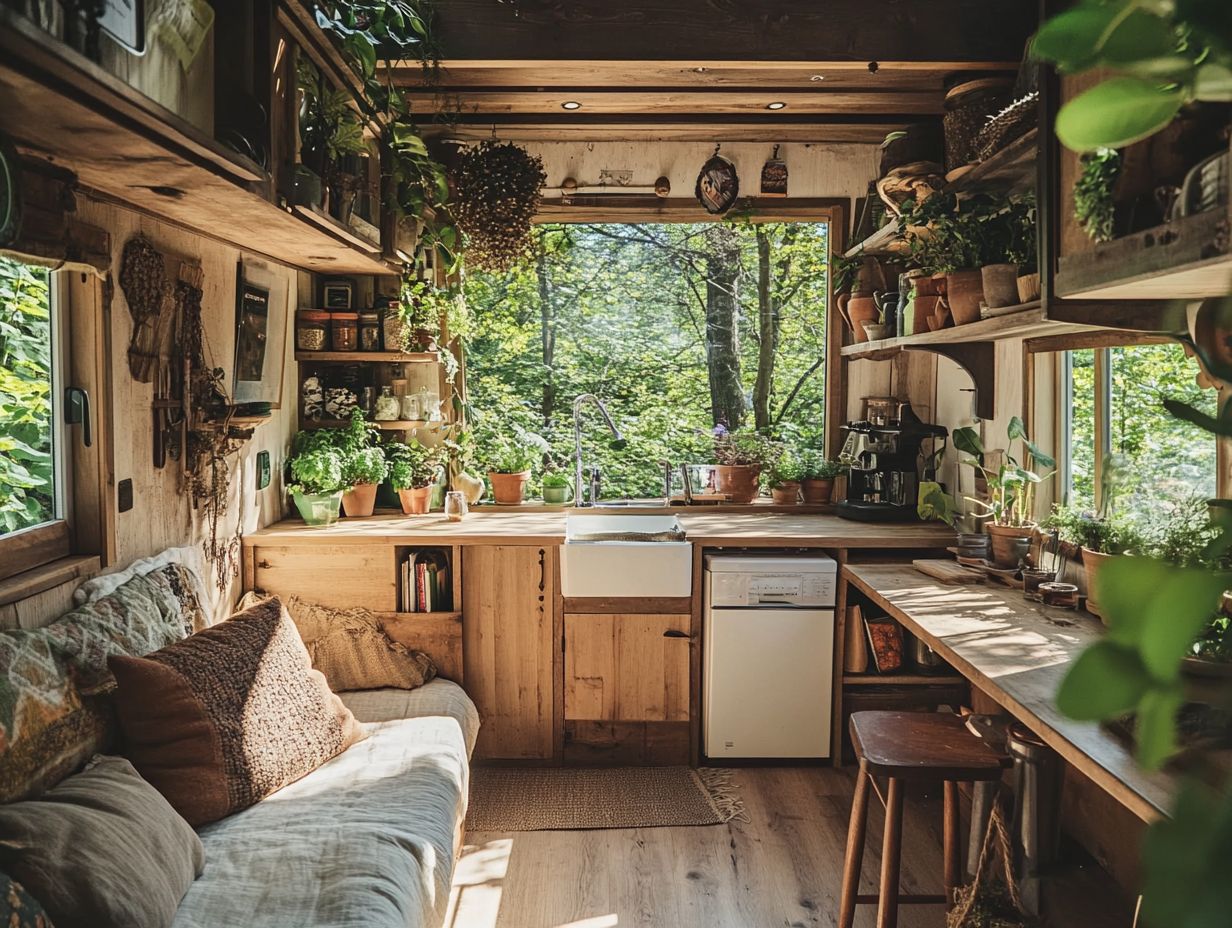
Maintaining and caring for eco-conscious materials in your tiny home is essential for ensuring their longevity and reaping the rewards of eco-friendly living. Regular upkeep preserves the performance of materials like reclaimed wood and insulation while enhancing energy efficiency. Maximize the lifespan of your materials and enjoy long-lasting benefits!
Routine cleaning is key. Opt for natural cleaning agents to help prevent the degradation of surfaces. It’s wise to regularly inspect for wear and tear, especially in moisture-prone areas, as these often pose challenges like mold growth.
Properly sealing and treating your wood enhances its aesthetic appeal and protects it from pests and weather-related damage. By being proactive, you ensure that your eco-friendly investments remain effective, ultimately fostering an environmentally conscious lifestyle built on durability and responsibility.
Frequently Asked Questions
What are eco-conscious materials and why are they important for tiny living?
Eco-conscious materials are sustainable, biodegradable, and have a minimal impact on the environment. They are important for tiny living because they help reduce our carbon footprint and contribute to a healthier planet.
How can I identify eco-conscious materials for my tiny living space?
Look for materials made from natural, renewable resources such as:
- Bamboo
- Cork
- Reclaimed wood
Also, check for certifications like FSC (Forest Stewardship Council) or Cradle to Cradle, which ensure the sustainability and environmental impact of the materials.
What are some eco-friendly alternatives to traditional building materials for a Tiny Home?
There are many eco-friendly alternatives to traditional materials, such as:
- Recycled glass or plastic for countertops
- Natural clay or lime for walls
- Eco-friendly insulation made from sheep’s wool or recycled denim
- Hempcrete and Straw Bales for insulation and walls
How can I ensure that the materials I choose for my Tiny Home are non-toxic?
Look for materials that are low or zero-VOC (volatile organic compounds), which means they do not emit harmful chemicals into the air. Research the ingredients used in the materials and opt for natural, non-toxic alternatives.
Are there any eco-conscious materials that are also cost-effective for Tiny Homes?
Yes, many eco-friendly materials are cost-effective. For example, bamboo is a sustainable and affordable option for flooring and furniture, and recycled metal can be used for roofing and siding.
What are some tips for choosing eco-conscious materials for my Tiny Home on a budget?
Consider repurposing materials from thrift stores or salvage yards. This not only reduces waste but also saves money.
Look for local suppliers or join community resource exchanges. These options can help you find affordable, eco-friendly materials.
Source building supplies from local eco-conscious businesses in areas like Nebraska or San Antonio. This choice can help shrink your carbon footprint, meaning you’ll lower your impact on the environment.
Finding eco-friendly materials can be both fun and affordable! Start your Tiny Home project with sustainable choices today.


